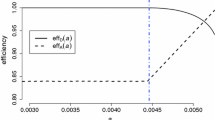Abstract
A maximin model for IRT-based test design is proposed. In the model only the relative shape of the target test information function is specified. It serves as a constraint subject to which a linear programming algorithm maximizes the information in the test. In the practice of test construction, several demands as linear constraints in the model. A worked example of a text construction problem with practical constraints is presented. The paper concludes with a discussion of some alternative models of test construction.
Similar content being viewed by others
References
Anthonisse, J. M. (1984).Linprog. Amsterdam: Centre for Mathematics and Computer Science CWI.
Birnbaum, A. (1968) Some latent trait models and their use in inferring an examinee's ability. In F. M. Lord & M. R. Novick, Statistical theories of mental test scores (pp. 379–397). Reading, MA: Addison-Wesley.
Boekkooi-Timminga, E. (1987) Simultaneous test construction by zero-one programming.Mehtodika, 1, 101–112.
Boekkooi-Timminga, E., & van der Linden, W. J. (1987). Algroithms for automated test construction. In F. J. Maarse, L. J. M. Mulder, W. P. B. Sjouw, & A. E. AkkerComputers in psychology: Methods, instrumentation and psychodiagnostics (pp. 165–170). Lisses: Swets & Zeitlinger.
Dantzig, G. (1957). Discrete-variable extremum problems.Operations Research, 5, 266–277.
Kelderman, H. (1987)Some procedures to assess target information functions. In W. J. van der Linden (Ed.), IRT-based test construction (Research Report 87-2, chap. 4). Enschede: University of Twente, Department of Education.
Lord, F. M. (1980) Applications of item response theroy to practical testing problems. Hillsdale, NJ: Lawrence Erlbaum.
Pandey, T. N. (1986). State of the art of large-scale assessment in the United States. In W. J. van der Linden & J. M. Wijnstra (Eds.), Ontwikkelingen in de methodologie van het onderzoek [Developments in the methodology of educational research] (pp. 5–25). Lisse: Swets &Zeitlinger.
Rao, S. S. (1985).Optimization: Theory and applications (2nd Ed.). New Delhi: Wiley Eastern.
Rasch, G. (1960).Probabilistic models for soem intelligence and attainment tests. Copenhagen: Denmark Paedagogiske Institut.
Theunissen, G. J. J. M. (1985). Binary programming and test design.Psychometrika, 50, 411–420.
Theunissen, T. J. J. M. (1986). Optimization algorithms in test design.Applied Psychological Measuremetn, 10, 381–389.
Theunissen, T. J. J. M., & Verstralen, H. H. F. M. (1986). Algoritmen voor het samenstellen van toetsen [Algorithms for constructin tests]. In W. J. van der Linden (Ed.),Moderne methoden voor toetsconstructie en -gebruik [Modern methods for test construction and use] (pp. 32–39). Lisse: Swets & Zeitlinger.
Timminga, E. (1985).Geautomatiseered toetsontwerp: Itemselectie m.b.v. binair programmeren [Automated test design: Item selection usin binary programming]. Unpublished masters thesis, Uniersity of Twente, Enschede, The Netherlands.
van der Linden, W. J. (1987). Automated test construction using minimax programming. In W. J. van der Linden (Ed.),IRT-based test construction (Research Report 87-2, chap. 3). Enschede: University of Twente, Department of Education.
van der Linden, W. J., & Boekkooi-Timminga, E. (1988). A zero-one programming approach to Gulliksen's matched random subtests method.Applied Psychological Measurement, 12, 201–209.
Wagner, H. M. (1975.Principles of operations reserarch. London: Prentice-Hall.
Yen, W. M. (1983). use of the three-parmeter model in the development of a standardized achievement test. In R. K. Hambleton (Ed.),Applications of item response theory (pp. 123–141). Vancouver: Educational Research Institute of British Columbia.
Author information
Authors and Affiliations
Additional information
The authors are indebted to Jos J. Adea for suggesting Equation 17 as a Simplification of an earlier version of this constraint. This research was suuorted in part by a grant from the Dutch Organization for Research (NWO) through the Foundation for Psychological and Psychonomic Research in the Netherlands (Psychon).
Rights and permissions
About this article
Cite this article
van ver Linden, W.J., Boekkooi-Timminga, E. A maximin model for IRT-based test design with practical constraints. Psychometrika 54, 237–247 (1989). https://doi.org/10.1007/BF02294518
Received:
Accepted:
Issue Date:
DOI: https://doi.org/10.1007/BF02294518




